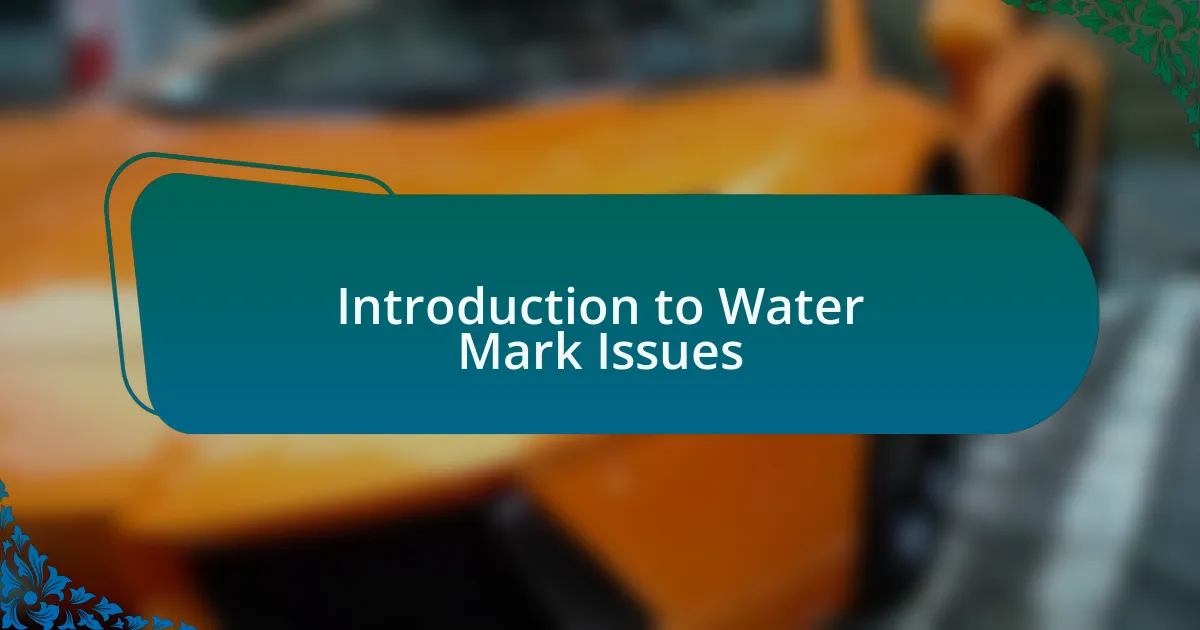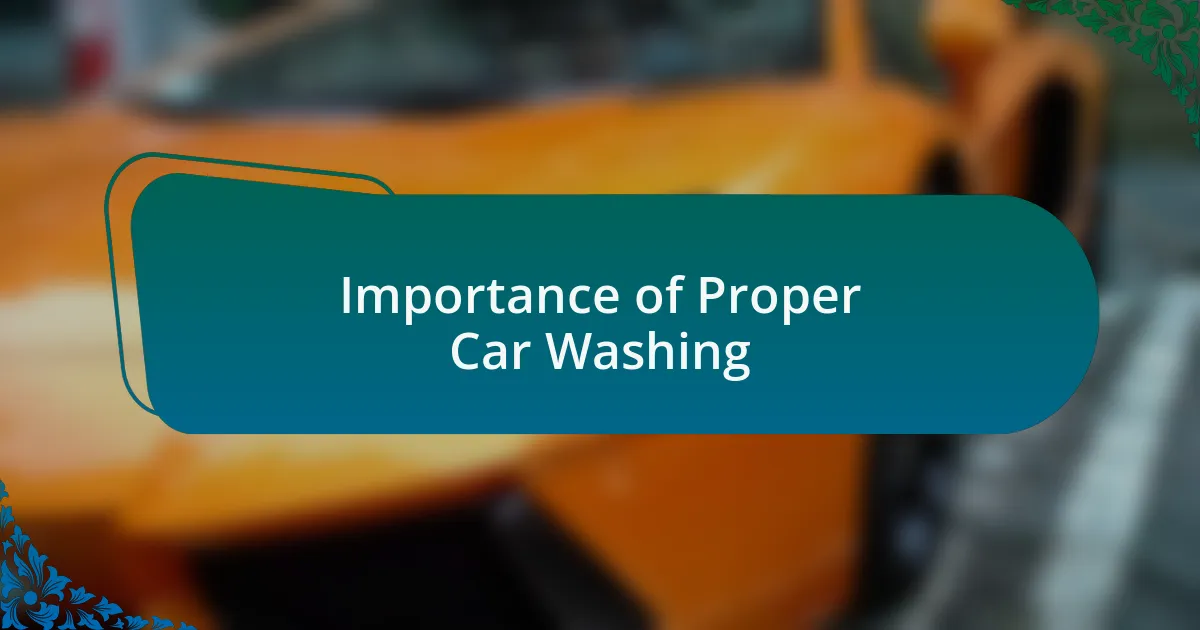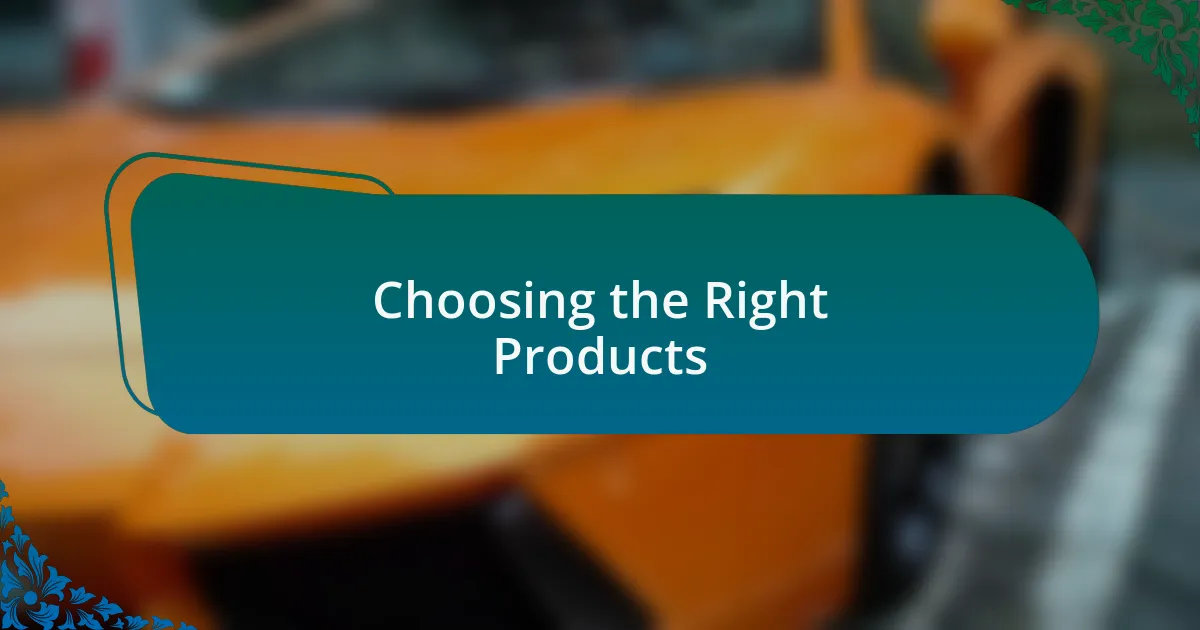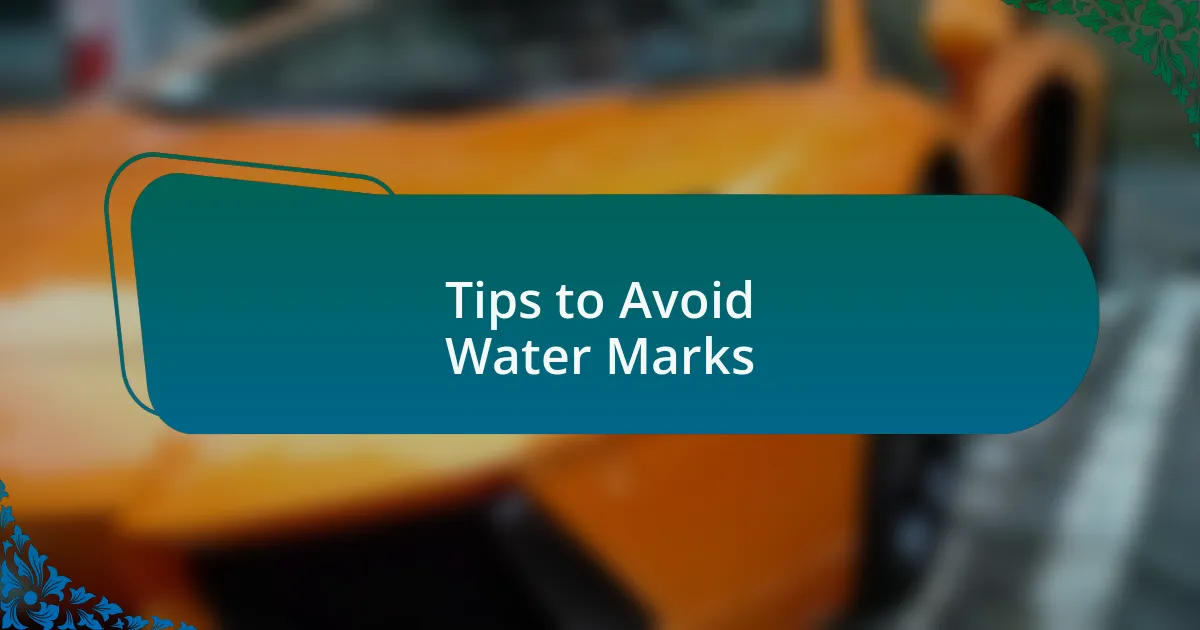Key takeaways:
- Water marks are caused by mineral deposits left after water evaporates, often frustrating car owners after a wash.
- Proper car washing techniques, including rinsing in the shade and using softened water, can prevent water marks and extend the life of the vehicle’s paint.
- Using the right products, such as pH-balanced car shampoos and microfiber towels, is crucial for achieving a spotless finish and protecting the vehicle’s surface.
- Implementing methods like the two-bucket rinse system and drying with a leaf blower can significantly improve the rinsing process and minimize water spots.

Introduction to Water Mark Issues
Water marks can be a real headache for car enthusiasts and casual drivers alike. I remember the first time I detailed my car and, after hours of hard work, I stepped back to admire my handiwork, only to find those frustrating white spots all over the surface. It made me wonder, why do these pesky marks always seem to appear right when you least want them?
These marks usually result from mineral deposits left behind after water evaporates. This is particularly frustrating after a fresh wash, when you’re expecting a gleaming finish. Have you ever experienced that moment of realization when you think your car looks spotless, only to find that it’s dotted with water marks that tarnish the overall effect? It can really take the joy out of car care, especially when you put in so much effort.
Understanding the causes of water marks is the first step in preventing them. I’ve found that knowing what to look for can save a lot of disappointment down the line. The last thing you want is to invest time and money into a car wash, only to chase after those stubborn spots afterward!

Importance of Proper Car Washing
Maintaining a proper car washing routine is essential not just for aesthetics but also for the longevity of your vehicle. I recall when I neglected a thorough wash for weeks; dirt and grime accumulated, leading to potential damage. Did you know that failing to wash your car regularly can lead to corrosion and paint damage? It’s a real concern that many drivers overlook.
Another crucial aspect of car washing is protecting your investment. A clean vehicle not only looks good but also attracts more buyers if you decide to sell. I once sold a car after keeping it meticulously detailed, and the difference in offers was staggering compared to similar models that had been left to accumulate dirt. Wouldn’t you want your vehicle to stand out for all the right reasons?
Proper washing techniques can prevent the development of those frustrating water marks we’ve talked about, saving you the hassle of redoing your work. I’ve learned that using the right products and methods can create a finish that not only shines but lasts longer. So, why take chances with your vehicle’s appearance when a little effort upfront can pay off handsomely?

Techniques for Rinsing Cars
Rinsing effectively is a cornerstone of achieving that crystal-clear finish without unwanted water marks. I remember a time when I rushed through the rinsing process, only to find unsightly spots all over the paint after it dried. It taught me the value of using a high-pressure nozzle; not only does it help wash away soap and dirt, but it also reduces the chances of those pesky left-behind water droplets that can lead to spots.
I’ve found that the timing of your rinse can significantly impact the final results. For instance, rinsing in the shade rather than direct sunlight can prevent the water from evaporating too quickly, which often results in those irritating streaks. I once made this mistake during a midday wash, and I learned the hard way that patience is key—waiting for the right conditions can make all the difference.
Additionally, using filtered or soft water instead of hard tap water is a game-changer. I switched to softened water a while back and noticed a remarkable reduction in streaks and spots. Isn’t it refreshing to see your car dazzle without the worry of those annoying marks left behind? Investing in your rinsing technique truly pays off with an immaculate shine that you can be proud of.

Choosing the Right Products
Choosing the right products for rinsing can truly elevate your car wash game. I’ve experimented with various rinse agents and found that dedicated car wash shampoos, specifically formulated to prevent water spots, make a noticeable difference. Why settle for generic options when you can use products designed with your car’s finish in mind?
In my experience, using microfiber drying towels in conjunction with a quality rinse product not only speeds up the drying process but also minimizes the risk of scratches. I remember a wash where I relied solely on cotton towels and was left frustrated by the fine swirls left on the paint. That was when I realized that the right drying tools are just as crucial as the rinsing agents.
Another factor to consider is the pH level of the products you choose. For example, I’ve opted for pH-balanced solutions that won’t strip away wax or sealants, extending the life of my car’s protection. Have you ever noticed how a pH imbalance can lead to dullness? Investing in the right products doesn’t just save time; it gives you that deep, rich shine that truly makes your car stand out on the road.

My Personal Rinsing Methods
When it comes to rinsing techniques, I’ve found that a two-bucket method truly transforms the process. Picture this: one bucket filled with clean, soapy water and another with just clean water for rinsing my mitt. The moment I switched to this method, I noticed a significant reduction in water spots. It’s as if I unlocked a secret weapon against grime, and I can’t help but wonder why I waited so long to make the change.
I’ve also embraced the use of a spray-on wax after rinsing. It’s an effortless way to add a protective layer that not only reduces water spotting but also enhances that glossy finish. I recall one sunny afternoon, applying spray wax after a wash, feeling a sense of satisfaction as the sun glinted off my freshly cleaned car; it was simply breathtaking. It made me realize how a little extra effort can yield a lasting impression.
One tactic that has really stood out to me is using a leaf blower as a drying tool. Sounds unconventional, right? But after a few tries, I was amazed by how it eliminated almost every last drop of water without any risk of scratches. That exhilarating moment of seeing my car dry to perfection without those pesky water marks felt like a victory. Isn’t it satisfying to discover tools that make the entire process smoother?

Tips to Avoid Water Marks
To prevent those annoying water marks, I’ve found it crucial to dry my car using microfiber towels. These towels, with their soft textures, do a fantastic job of absorbing moisture without scratching the paint. It’s surprising how just a simple switch can make a big difference; I recall a time when I used regular towels and ended up with streaks all over. Have you ever felt that frustration?
Another tip that has worked wonders for me is washing the car in the early morning or late evening. During these times, the sun is less intense, so the water doesn’t evaporate as quickly, reducing the chances of water spots forming. I vividly remember a scorching afternoon wash that left my car looking like a spotted puzzle—not a great end to my hard work! Now, I time my washes to avoid the sun, and it makes a world of difference.
Lastly, using distilled water for rinsing has proven effective in eliminating water marks. Distilled water is free of minerals that can cause those unsightly spots. One day, as I was rinsing my car with tap water, I found myself frustrated by the stubborn spots left behind. That’s when I decided to give distilled water a try, and now it feels like I’ve found a secret ally in the fight against water marks. How can something so simple transform the finish of your car so dramatically?